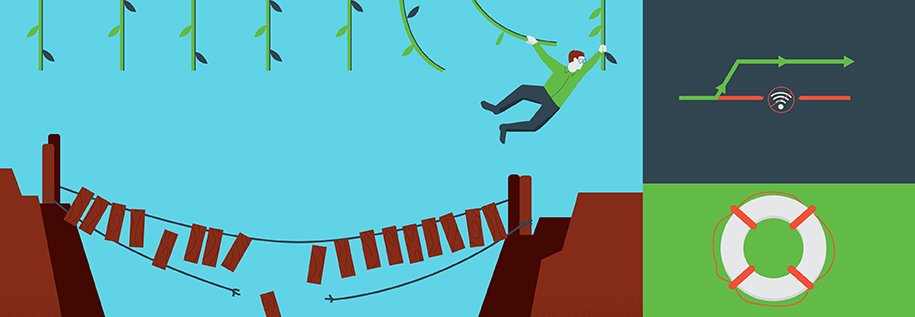
No matter what internet connection or connections you have, they’re each going to have downtime and at times be practically unusable because of performance issues. Based on our customer data, we’ve calculated that ISP connections are providing an average of 93.1% of usable uptime. The remaining 6.9% translates to an average of 604 hours per year of effective downtime. And with so many important business technologies moving to the cloud, even a small amount of downtime is going to be painful and costly.
That’s why having a secondary internet connection that provides failover coverage is more than just a good idea; it’s now crucial for any modern business that relies on the internet.
That said, there are a lot of options and things to think about when choosing a second (or third) internet connection and creating the right internet failover setup for your business — whether it’s the first time your business or organization will have a backup internet connection, or you’re looking for a better and more reliable option.
Your primary goal
- Getting your uptime percentage as high as possible?
- Having the least possible downtime when a natural disaster hits your area?
- Improving the performance of a particular cloud technology — like video or VoIP calls, your CRM, or an application that’s specific to your industry or business?
- Avoiding interruptions when you fail over from one internet connection to another? For example, making sure VoIP calls or VPN sessions don’t drop.
- Something else? Explicitly identifying your main goal or goals will help you make the best decisions for your business and help you explain them to your manager, executive team, or company
All sorts of things can take an internet connection down:
- ISP outage
- Scheduled or unscheduled maintenance
- Natural disasters
- Cyberattacks
- Human error
- Hardware problems or failure
- Power outage
- Someone cutting a line to your building
- Spikes in latency or packet loss that make the internet unusable
Getting the most out of your secondary internet connection(s)
ISP diversity
Last-mile diversity
The uptime of different connection types
Leveraging your internet failover setup
Think about outages and performance
Many traditional internet failover options — like dual-WAN firewalls and BGP routers — only jump into action when your primary internet connection fails completely. They don’t have any awareness of network performance metrics for things like packet loss, latency, and jitter that can make the internet practically unusable when they occur, especially when using Zoom, Teams, or other VoIP services. For many businesses, these performance issues are a bigger and more common problem than full-fledged outages. A basic failover setup will be of little help, as they monitor for connectivity failures, not connection health.
IP address change
When your primary internet connection fails and your traffic is moved to your secondary connection, do you want your users’ IP addresses to change or stay the same? For more simple things like email or loading web pages, a change in IP address isn’t a big deal and your users won’t know that your internet was having any issues. However, many cloud- and internet-based applications aren’t so forgiving.
Here are some of the things that can happen when an internet failover changes your IP address:
- VoIP calls drop
- VPN sessions disconnect
- Virtual desktop sessions drop
- SSH sessions drop
- Valuable data is lost while people are editing electronic health/medical records, CRMs, etc
Active-active or active-passive configuration
Bi-directional Quality of Service (QoS)
Traditional failover options generally have not control over your download traffic. This could be fine for your business, but if you’d like to prioritize important traffic that’s particularly susceptible to internet performance issues over bulk downloads, for example, VoIP or video calls, or to be able to route upload and download traffic on different circuits based on the best path, you’ll want a failover option, like Bigleaf’s, that provides this bi-directional QoS.
Other optimizations
Beyond simple failover—when one of your internet connections goes down completely—there is a lot that can be included in a failover setup to prioritize and route different types of traffic so that your most important technologies work as well as they can. This can be done through either policies and custom configurations or intelligently-powered software.
How much time do you have?
With policies and custom configurations, you spell out all the things you think your failover setup will need to know—from telling it how to recognize traffic for your organization’s most important applications, to what to do if the packet loss on a circuit crosses a certain threshold. This gives you full manual control, but also takes a lot of time and creates opportunities for human error.
Another thing to keep in mind is that your policies and configurations can only be as good as what your team knows about and has the time to update. For example, when an employee uses a new application they didn’t get from the IT team—a potential customer invites your salesperson to a video conference on a different platform, or the new tool a team is trying out—they won’t get the preferred experience they do with the applications you’ve created manual policies for.
Intelligently-powered software
If you include intelligent software as part of your internet failover setup, it can automatically monitor your circuit performance, detect and classify new technologies and traffic types on your network, and route and reroute your traffic to prevent disruptions. Instead of manually creating policies and configurations to try to account for anything that could happen, you can use software that incorporates all the knowledge from the networking experts who created it…the businesses that have already used it.
Adding this intelligence to your internet failover setup is something to seriously consider if you don’t have the time or people to write, test, and debug thousands of lines of policies and configurations, or if the uptime and performance of your cloud-and internet-based technologies is particularly important to your business.







